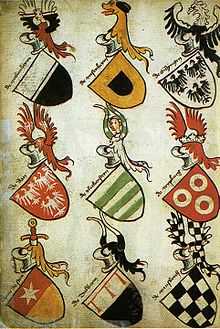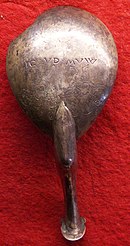Dahn (noble family)
Dahn , also Tan, Tann or Thann, is the name of a Palatine noble family.
Surname
The name Dahn , Tan , Tann or Thann occurs more frequently as a family name with these variations. For example, there is also a Franconian noble family called Tann . Anshelmus de Tannicka , often referred to in literature as the progenitor of the Lords of Dahn , apparently did not belong to the Palatinate Dahners, but only had a similar name.
Ministerial of the Bishops of Speyer
Presumably the Dahner resident in the southern Palatinate Forest did not immigrate there, but an old-established family. At the end of the 12th century they appeared several times as Reichsministeriale , but then more and more often acted as Ministeriale of the Bishop of Speyer . The servants of important ecclesiastical or secular gentlemen were called ministerials. They were originally unfree who were employed by their masters in the administration of goods. Some of them made careers in the administrative administration of their masters and achieved social advancement, which quickly let their former bondage be forgotten. An old fiefdom of the Dahner family was mentioned in 1285, which was owned by the family from the Speyer diocese in Hinterweidenthal not far from Dahn and which came from the Hornbach monastery . It is therefore quite possible that the Southwest Palatinate or Wasgauer Dahner originally came from the followers of the Hornbach monastery. This connection could be the reason why the Dahner first appeared as Reichsministeriale and then more and more as Ministeriale of the bishop.
Dahner Burgengruppe
The family seat was probably Altdahn Castle . The first mention of a castle property on May 3, 1285 refers to Neudahn Castle (also Speyerische Lehensburg), as can be seen from the list of goods. The three castles of the Dahner Burgengruppe , especially Altdahn and Tanstein, are likely to be a bit older. Until 1327, all castles on the Dahner Schlossberg were referred to as Burg Than , only then did individual names establish themselves. Occasionally, Tanstein was still referred to as Alt-Than . In 1288, four Dahn knights were mentioned in a document in the castle : Konrad III. Mursel, Johann I., Heinrich IV. Sumer and Konrad IV. Von Dahn. The space requirement is likely to have been very large, which is why it is assumed that all five castle rocks will be built on, whereby Alt-Dahn and Tanstein are probably the oldest parts due to the few evidence.
Neudahn, away from the castle group, was first mentioned in 1340 as nuwenburg zu Than . Overall, the early history of the Dahn Ministerials is largely unclear due to complex ownership and family relationships.
As the first owner of the Dahn fief, Friedrich I. von Dahn is documented between 1198 and 1236. At that time the castle was already an episcopal fief. From Berwartstein Castle , very close by, we know that Emperor Friedrich I gave it to the Speyer Monastery in 1152 as thanks for its support. As a result, this imperial castle became an episcopal feudal castle for the imperial ministers, ministerials of the bishop, who were seated there. A similar development is assumed for the Dahner fiefdom.
With the death of Johann I von Dahn in 1319, the family lost control of the third castle, Grafendahn, between Alt-Dahn and Tanstein . After a feud over the inheritance, the Speyer bishop re-awarded the fief and it went to the Counts of Sponheim .
At the beginning of the 15th century, the Dahn knights got into trouble. Johann VII. And his brother Heinrich X. von Dahn refused in 1399, with Count Palatine Ruprecht III. to attack Tannenberg Castle because members of the family were staying in the castle. The king had Neu-Dahn Castle confiscated. But it was later returned. Henry XIII. von Dahn zu Tanstein was a follower of Franz von Sickingen . In the course of the Sickingi feud, Tanstein was occupied by Kurtrier soldiers and was not returned until 1544.
With the end of the Middle Ages, the Dahn castles had lost a lot of their importance and fell into disrepair. Ludwig II von Dahn had a small castle built in Burrweiler , which was first mentioned in 1571. Only one archway remains from the complex. The family died out with Ludwig II von Dahn, who died in Burrweiler in 1603. The fiefs fell back to the diocese of Speyer .
coat of arms
The von Tann family coat of arms are three silver eagles (2: 1) on a red background. On the helmet with red and silver blankets, a monkey holding a mirror in his right hand.
Coat of arms of Bishop Konrad IV von Tann
The prince-bishop's coat of arms of Konrad IV. Von Tann as bishop of Speyer (1233–1236) is usually four . The fields of the coat of arms alternate between the von Tann family coat of arms and the coat of arms of the Speyer diocese, a silver cross on a blue background.
literature
- Stefan Grathoff: The Dahner castles. Alt-Dahn - Grafendahn - Tanstein. Guide booklet 21. Edition Castles, Palaces, Antiquities Rhineland-Palatinate. Schnell and Steiner, Regensburg 2003. ISBN 3-7954-1461-X
- Alexander Thon (Ed.): ... like a banned, inaccessible magic castle. Castles in the southern Palatinate . 2., verb. Aufl. Schnell + Steiner, Regensburg 2005, ISBN 3-7954-1570-5 , pp. 19-25,31,113.
Web links
Individual evidence
- ↑ a b Grathoff 2003 p. 6
- ↑ Thon 2005 p. 113.
- ↑ Thon 2005 p. 31.
- ↑ Grathoff 2003 p. 4.
- ↑ www.burrweiler.de , Historical
- ↑ Hans Ammerich : The Diocese of Speyer and its history , Volume 2: From the Staufer period (1125) to the beginning of the 16th century ; Kehl am Rhein 1999; ISBN 3-927095-44-3 . Pp. 4-6.




